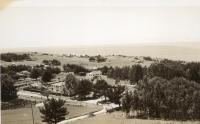There’s lots of talk these days about two “hot” and scary topics: an earthquake that turns San Francisco into the “temporary city” and a super-flu that makes the 1918 pandemic look like the common cold. And there are many books to choose from about these horrific possibilities, among the latest “A Crack in the Edge of the Earth:America and the Great California Earthquake of 1906” by Simon Winchester (about the freakishness of geology that I’m currently devouring) and “The Great Influenza: The Epic Story of the Deadliest Plague in History” by John M. Barry which I will read next.
In these strange times echoing with uncertainty on all sides, these non-fiction books seem like good old Stephen Kingish horror stories.
Many years ago I had already read “America’s Forgotten Pandemic: The Influenza of 1918” by Alfred Crosby which I highly recommend. In addition I read author Katherine Anne Porter’s personal account of how she survived the 1918 pandemic in her short story, “Pale Horse, Pale Rider”. Ms. Porter was in such fear that she wouldn’t allow herself to drift off into sleep–she had convinced herself she wouldn’t wake up if she closed her eyes.
Figures on deaths worldwide from this fast-moving flu have increased from what I initially read was about 22 million to 50 to 100 million. And now there are reports that the flu was a bird flu.
The San Mateo County Coastside, reeling from the failure of the Ocean Shore Railroad to open up this isolated, gorgeous stretch of artichokes and lonely beaches, became a health- haven for San Franciscans fleeing the deadly influenza in 1918. But the Coastside didn’t escape the flu–the community, widely spread between farms, bungalos serving as vacation homes for railroad commuters, and a couple of tiny agricultural towns, didn’t escape the deaths and because of the close-knitness of the people, these losses were keenly felt.
In 1918 ( just as in 1906 when some earthquake- fearing city folks, fled to the Coastside where they hoped the ground wouldn’t shake beneath their feet) entire families sought safety on the Coastside. Hard-to-rent Ocean Shore RR-era cottages became homes again in a previously lackluster real estate market.
 The Coastside was sparsely populated, thought to be a perfect place to flee from the killer 1918 flu.
The Coastside was sparsely populated, thought to be a perfect place to flee from the killer 1918 flu.
Just as people rushed into the Coastside, some rushed out. Miss Irmagarde Hazard, a teacher at the Montara School, packed her bags and left for San Luis Obispo, hoping she would outrun the worldwide epidemic.
The killer flu struck the Coastside in mid-September. Two important members of the community fell ill, the rural postal delivery man and a Catholic priest.
